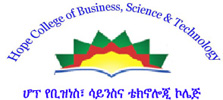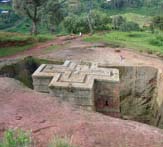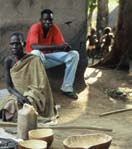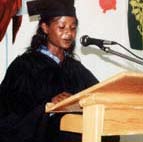|
BackgroundHope Enterprises or Hope is a local NGO that was established in 1971 in Addis Ababa to help the needy help themselves through basic needs, education, competence, job and business mediation and value education. As Hope was completing its 32 years of humanitarian service in 2003, it’s then Executive Director, Dr. Minas Hiruy, recommended to the Board the establishment of an outstanding liberal arts university college by submitting a full-fledged proposal. After some discussion, the Board and the General Assembly of Hope accepted the proposal, establishing Hope University College as the first public benefits institution of higher learning in the country on November 25, 2003. Soon after, the Board adopted a new structure comprising the Ladders of Hope that subsumed the existing and non-college activities of Hope as one division and Hope University College as another division, opening the way for the university college to operate autonomously. With Dr. Minas being appointed as the founding president of the university college starting from July 1, 2004, the development of the institution began to roll step by step. The city government leased to Hope five hectares of prime land in Addis Ababa for the amount of 14.95 Million Birr to build the various complexes of the university college. The master plan of the university college was designed free of charge by an international firm called Geluk Treurniet Architecten of the Netherlands and was handed over to Hope on November 11, 2004 in a ceremony in Rotterdam, where the Minster of Development Cooperation and the Ethiopian Consul were guests of honor. Dr. Minas began the fundraising phase preparing a project proposal requiring an initial investment cost of Birr 46,124,435.00 for the construction and equipping of the university college and distributed the same to various donors. Woord & Daad, the major donor of Hope Enterprises, was the first organization that he approached for help. Woord & Daad was supportive of the proposal and decided to fund a third of the expenses provided that Hope raised the remaining funding first. This pledge was not only an important seed fund but also a motivating note to get Dr. Minas running on the fundraising trail. Dr. Minas did indeed cover a lot of funding sources within country and abroad. The one place where Dr. Minas went to was Ethiopiaid/UK, the major donor of the Addis Ababa operations of Hope. Ethiopiaid, in turn, pledged to provide most of the remaining money, which came to be the highest amount provided by a single donor. Owing to this provision, Ethiopiaid was made the principal sponsor of Hope University College by mutual consent. Soon after, Woord & Daad released its funding in installments. Other donors such as Menlo Park Presbyterian Church, First Presbyterian Church of Fresno, Ethiopiaid/Ireland and various individuals like Ms. Sally Anderson, Mr. Henk de Pagter, Mr. Klaas de Wit and Ato Mekuria Jimma contributed what they could being featured as the rest of the founding donors to an initiative of hope that may transcend generations. To support the proper formulation and execution of the academic plan and construction of the university college, an educational consortium on one hand and a construction consortium on the other with members from Ethiopia and abroad were set up in November 2004 and began to function with zeal meeting in the Netherlands and Ethiopia. In April 2005, Abba Architects Plc., a local architectural firm, was appointed to draw the detailed plans of the master plan of the university college, help in the selection of a building contractor and supervise the construction. The search process for a building contractor was undertaken all throughout 2006 following a competitive international tender. On December 2, 2006, Hope held a ground breaking ceremony with the President of Ethiopia, H.E. President Girma Wolde Giorgis, being the guest of honor, awarding the founding members and laying the cornerstone of the university college right on the site amidst no less than 600 guests. Following the processes of short listing and bidding involving no less than eight building contractors, a Chinese company, China Jiangsu International Economic-Technical Cooperation Corporation, was awarded the contract on June 19, 2007, to undertake the construction of the university college within a three-year period. A project agreement between Hope on one hand and the Ministry of Education and the Disaster Prevention and Preparedness Agency of the federal government on the other was signed to get the construction started. As the university college evolved gradually, Ethiopiaid/UK and Woord & Daad, wishing to have a mechanism to channel suggestions to help make Hope University College an institution of excellence, recommended to the Board of Hope the establishment of an advisory board constituted of two representatives from each of the cited donors and Hope and two more persons to be nominated by the principal sponsor and approved by the representatives. It was also suggested that the members of the advisory board shall be volunteers and selected on the basis of what they can contribute professionally with their term being limited to three years and with the decisions of the advisory board being made by a vote of simple majority. The Board approved the proposal on September 24, 2008 with a proviso to have an observer from its members at each meeting of the advisory board to link the advisory board and the Board. With this decision, the advisory board became a part of the university college’s governing structure. With such background of vision, partnership and government cooperation to bring the university college to reality, the Board of Hope Enterprises had adopted the following charter as the policy and procedures to guide the operations of Hope University College. In the meantime, the construction progressed well though by April 2009 sky rocketing inflation of building materials and variation costs raised the expenditure of the construction, equipping and furnishing to about Birr 90 million. Dr. Minas became busy in looking for the remaining funding. This effort finally paid off as Woord & Daad and Ethiopiaid/UK came up with the bulk of the fund needed and other individuals and organizations contributed what they could to close the gap. The work on the curriculum and organizational aspects of the university college also began. To help in these regards, the vice president for academic affairs and the vice president for administrative and financial affairs were hired in January 2009. Furthermore, the curriculum consortium, spearheaded by Dr. Corne Cocks and Mrs. Jolanda Berntsen of the Netherlands and the special inputs of Dr. Doug and Betty Holland of the US, who moved to Ethiopia to help us frame the curriculum helped in the development of the six departments that were subsumed in three faculties for the initial operation of the university college. At the same time, Dr. Minas wrote the draft charter and presented the same to the Advisory Board. The Advisory Board made minor modifications on the draft and the final draft was submitted to the Board, which endorsed the draft as the charter of Hope University College on June 3, 2009. |
|
||||||||||||||
Copyright © 2015 Hope University College in Addis Ababa, Ethiopia |






